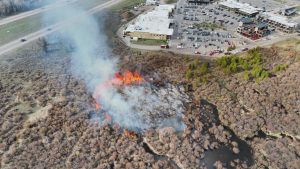Gravel mine between Silverthorne, Kremmling moves through state permitting process

Peak Material’s Peak Ranch Resource Project, a proposed gravel mine operation in Silverthorne, is moving forward with the state’s permitting process.
Peak Materials posted comments and the company’s responses to its website, including preliminary review comments from the Colorado Division of Reclamation, Mining and Safety, comments from Summit County and 142 objection letters.
The company is currently in the permitting process with the state. If the permits are awarded, Peak Materials will then have to obtain two permits from Summit County before the project can begin: one to mine materials on the 75-acre Hillyard property, between Silverthorne and Kremmling on US Highway 40, and one to import the materials to the company’s Maryland Creek Ranch facility, about 11 miles south of the mining site.
Peak Materials is proposing to mine the gravel deposit on the property, and then load the material into trucks bound for the Maryland Creek Ranch facility, where the gravel will be processed into construction products like sand, gravel, asphalt and concrete. Once the mining operation is complete, the company plans to convert the property to open space. The company estimates the lifespan of the mine, including reclamation, to be 10-15 years.
“Peak Materials has assembled a highly-experienced team of experts to its system through the (Division of Reclamation, Mining and Safety) and county permitting processes. We are pleased with how things have progressed and looking forward to continuing through the process,” Peak Materials representative Joanna Hopkins said in a phone call with the Summit Daily News.
The project has been met with strong resistance from Friends of the Lower Blue River and Lower Blue Residents United. Group leaders have recently kicked up communication efforts with members as the project picked up again with the submission of the application after nearly two years of delay.
The Division of Reclamation, Mining and Safety response is lengthy, touching on project topics regarding traffic, topsoil, mitigation and groundwater. Peak Materials mining engineer Ben Langenfeld said now that Peak Materials has presented adjustments to the project application per comments and recommendations, the application will go through further review and then next steps like public comments and hearings will be organized. As for the project timeline itself, Langenfeld explained that mining and reclamation will happen simultaneously.
“With any gravel operation like this you are going to be moving your way horizontally across the land and as you mine out an area … you finish that land out, grade it to the final contour you want, you place the topsoil down, you seed and mulch and start to get the growth of the revegetation that’s going to follow along,” Langenfeld said.
Langenfeld discussed topsoil preservation during the project, which he said is required through any mining permit in the state of Colorado. However, the Hillyard property is what Langenfeld described as sandy and cobbly, without much existing topsoil. He said the plan is to take as much organic matter off the top of the property to be used as part of the reclamation process.
Peak Materials responses to Division of Reclamation, Mining and Safety comments include a note that the company is committed to not exposing groundwater prior to obtaining an approved permanent augmentation plan. Langenfeld explained that the mining phase is designed to stay above groundwater, but Peak Materials will apply for a permit to expose groundwater in the reclamation phase of the project, as the proposed reclamation includes a 26-acre groundwater lake.
Peak Materials’ proposed plan to the state says that Colorado Department of Transportation-approved improvements to Colorado Highway 9 will be completed prior to commencing operations. The review response states that based on results of a traffic study, the company plans to construct a left turn deceleration lane on Highway 9 into the site as well as a right turn acceleration lane on Highway 9 from the site.
Friends of the Lower Blue River Executive Director Jonathan Knopf was particularly concerned with the possibility of water contamination. He said that if an accident were to occur while mining where digging went too deep and contaminated groundwater, well water in the area, which many neighboring residents depend on, could be adversely affected.
“If they were to get into the level of where the water table is, simple physics supports water flowing downhill and our water in our wells could be affected dramatically and that’s a big concern that I have … If I lose water and I don’t have water to drink, my property and my 40 acres that I have on my property and my house are going to be worthless.”
Knopf said he is also concerned about infiltration of any pollutants that might get into the Blue River throughout the course of the project. He said that as the county attempts to bring the Blue River back to Gold Medal status, any chance of pollution to the river is not worth the risk.
“We’re playing with matches and we shouldn’t be. … At the end of the day they’re just not really fulfilling what the Lower Blue strategic action plan wants to accomplish. The Lower Blue Planning (Commission) was put together with the idea of preserving and maintaining the integrity of the environmental quality of the Lower Blue River valley,” Knopf said.

Support Local Journalism

Support Local Journalism
The Sky-Hi News strives to deliver powerful stories that spark emotion and focus on the place we live.
Over the past year, contributions from readers like you helped to fund some of our most important reporting, including coverage of the East Troublesome Fire.
If you value local journalism, consider making a contribution to our newsroom in support of the work we do.









